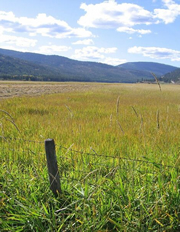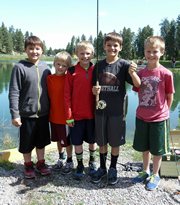Most of our work involves helping private landowners place conservation easements on their property.
Conservation easements are voluntary legal agreements that help landowners protect and secure the future of their land. Typically, conservation easements restrict subdivision and industrial activities. Under a conservation easement, the landowner continues to own and manage their property with the assurance that the open space, fish and wildlife habitat, wetlands and riparian habitat will be protected in perpetuity. Each conservation easement is crafted to meet the specific desires and needs of landowners for their properties.
It is important to note that under the terms of a conservation easement, the landowner continues to own and manage the property. The property can still produce crops, hay, livestock, timber and other commodities. The landowner still makes all the farm/ranch decisions and still pays property taxes. The goal of the easement is therefore to preserve open lands as well as the elements of the working farm or ranch. What a property under the terms of a conservation easement cannot produce are subdivisions or industrial activities.
“Our property has been in my family since it was homesteaded in 1885. It was important to me to keep it intact. The best way to do this was with a conservation easement. A conservation easement takes away the option we wanted to take away, subdivision.”
— Glenn Johnston, owner of a 700-acre conservation easement along the Flathead River
The conservation easement protects the lands in perpetuity, and the easement is recorded at the county courthouse with the county clerk and recorder. The land trust holding the easement monitors it on an annual basis and is also responsible for enforcing its terms.
Sometimes we work with landowners to transfer their property to a public entity (County, State or Federal) to maintain important resource values and enhance outdoor recreation and public land opportunities for the community.
Tax Benefits
A landowner can often receive tax benefits for placing land in a conservation easement. The donation of a conservation easement may permit the landowner to deduct the value of the easement as a charitable gift from his or her federal income tax. The value of the easement for purposes of the deduction is typically the difference in the value of the easement property before the donation of the conservation easement and after the donation. This value is often based on the development value of the land that will not be exercised by maintaining it as open space.
In 2015, Congress passed a law renewing the enhanced conservation easement tax incentive permanently. Learn more about this exciting tax incentive here>>.
Other tax benefits may exist, so we encourage landowners to consult their attorney or tax advisor to fully explore the estate and income tax benefits associated with the charitable donation of a conservation easement.
Other Financial Incentives
In some cases, funding is available to purchase conservation easements on lands with high resource values. Typically these lands are important to migratory birds, fish and wildlife, or have rich agricultural soils. The Flathead Land Trust can also assist with obtaining funding for projects that sustain and enhance outdoor recreational opportunities for the community.
See your financial advisor to discuss how specific tax benefits may work for you. Tax benefits vary greatly depending on your particular tax situation, complexities in the tax code, and whether the land is owned by an individual, partnership, corporation, limited liability company, or a trust.
For more information, contact your tax advisor and visit the Land Trust Alliance’s website







